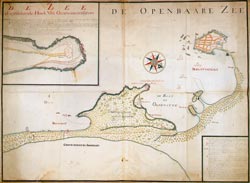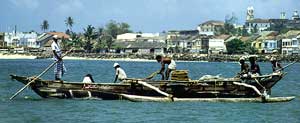 |
|
Maritime
Lanka |
16 Dec 2004
|
|||
| Last modified: 16 Dec 2004 |
The port town of Galle in the southwest of Sri Lanka has a splendid natural harbour. The port was in use in pre-Christian times, but gained in importance after the 12th century. By the 14th century it was arguably the most important port in the country, and it retained this preeminence until 1873 when an artificial harbour was built in Colombo. The great Chinese admiral Zheng He commemorated his visit by leaving a trilingual inscription in 1411; the three languages were Chinese, Tamil, and Arabic, implying a cosmopolitan trading community. The Portuguese arrived in 1505, and later built a small fort; but it was after Galle was captured by the Dutch in 1640 that the city rose to its greatest prosperity. The Dutch rebuilt the town and strengthened the fortifications.
The English took over in 1796 but made few changes to the infrastructure, and it is Dutch architecture of the 17th and 18th centuries which gives the town its present character and charm. Among the Asian ports of the United Dutch East India Company (Verenigde Oost Indische Compagnie, or VOC), Galle was second only to Batavia (now Jakarta).

Our earlier statement about the quality of the harbour has to be qualified. It is protected from the northeast monsoon but exposed to the southwest, and entrance to the harbour is dangerous because of the many submerged rocks and reefs. Even today, the difficulties persist; both wrecks and casualties are expected from year to year(1). Removal of dangerous rocks may have been discouraged by local legends that such disruption would cause Galle fort to subside into the sea.
 This map shows submerged rocks & reefs, and the flagpole - an important navigational beacon. It also marks the wreck of the Hercules, and shows ships at anchor in front of the Black Fort. |
Of the six VOC ships known to have sunk in or around the harbour, three were wrecked going in or out of the bay. Two were sunk inside the bay (one by an explosion at anchor and the second after coming adrift from her anchor), and one was wrecked outside the bay while waiting for the pilot to bring her in(2).
Galle harbour has an impressive number of heritage sites, some dating back well before the Dutch. Several stone anchors of Indo-Arabian pattern have been discovered, one weighing almost a ton (so implying a ship of some size), made of stone probably from Oman, and with a wooden anchor stock around five hundred years old. (The wooden stocks would have been regularly replaced, so the anchor itself may be older.) Another anchor has been found of Mediterranean pattern, similar to those used in Roman times. A celadon bowl of the Southern Song dynasty (C13th) is one of our few relics of the early trade with China; later blue-and-white Chinese tradeware is abundant.
 While
Sri Lankan archaeology is rich in treasures from much earlier periods, it is
the combination of several Dutch East India Company wrecks with the VOC's extensive
historical archives which makes Galle Harbour so interesting. The Dutch administrative
records and maps are helping us to identify the shipwrecks and to understand
the historical context. In 1993 the 'Chicken's Foot Wreck' was located, and
later identified as the Avondster.
Then we found an eye-witness account - complete with enough human failure and
recrimination to make the story interesting, but reassuringly reporting no casualties.
In 1999 we found the human skull
- so research goes on.
While
Sri Lankan archaeology is rich in treasures from much earlier periods, it is
the combination of several Dutch East India Company wrecks with the VOC's extensive
historical archives which makes Galle Harbour so interesting. The Dutch administrative
records and maps are helping us to identify the shipwrecks and to understand
the historical context. In 1993 the 'Chicken's Foot Wreck' was located, and
later identified as the Avondster.
Then we found an eye-witness account - complete with enough human failure and
recrimination to make the story interesting, but reassuringly reporting no casualties.
In 1999 we found the human skull
- so research goes on.
| Maritime Lanka homepage | VOC shipping |